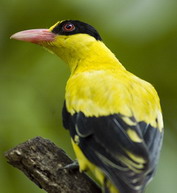|
Welcome To
Mt KINABALU NP
PAGE - SABAH
|
From Page 1 >>
FAUNA
Majority of Borneo’s mammals live in the lowlands
but some can be found in the lower montane forests.
Approximately 90 species of lowland mammals have
been recorded, leaf monkey, red leaf monkey,
orangutan, Borneo gibbon, linsang, and binturong.
Among these categories are numerous bat species,
slow loris, tarsier, grey binturong). Other larger
mammals recorded include the bearded pigs, sun
bears, sambar deer, barking deer and mouse deer. The
smaller mammals seen include the tree shrews,
squirrels (tree, ground and flying squirrels),
pangolins, porcupines while those likely to be
spotted at night are the palm civets, Malay weasels,
rats and mice, flying foxes and the leopard cats.

Kinabalu is also the home of a few species of
mammals classified as insectivores which feed only
or predominantly on invertebrates. Sightings of
Borneo's largest insectivore the Moonrat has been
recorded in the fringes of the Park while the Lesser
Gymnure is confined to the areas of the Park above
the lowland dipterocarp forests. The Black Shrew and
the Kinabalu Shrew are found only on Mt. Kinabalu.
The Ferret-badger is found at altitudes between 3600
feet and 13300 feet. It has close relatives in the
mountain ranges of mainland Asia and Java. However
in Borneo it is confined to Mt. Kinabalu and nearby
mountains.
Kinabalu recorded more than 326 species of birds,
categorized respectively into 4 groups; sub-alpine
species, endemic montane species, non-endemic
montane species and lowland species.

Some
22 species of montane birds which include the
Red-breasted partridge, Crrimson-headed partridge,
Everett’s thrush and Kinabalu serpent eagle. The
lowland birds are normally found below 3,300 feet.
In sub-alpine forests the little brown Sunda
Bush-warbler and the Short-tailed Bush-warbler are
often seen skulking about in the undergrowth above
6540 feet. The most common sub-alpine birds are the
black and red Mountain Blackbird and the smaller
dark olive-green Blackeye. Higher up above the tree
line the Blue and White-browed Shortwing can often
be sighted. If you are lucky enough, you might
encounter the Kinabalu Friendly Warbler.

There are as many as 200 species of butterflies,
mostly occuring below 6350ft in Kinabalu. About 112
small moth species have been identified, these can
be found at above 6000ft and are mostly active at
night.
There are lots of amphibian and approximately 61
frog and toad species have been recorded in Kinabalu
and many species of fresh water fishes, beetles,
snakes and terrestrial mollusks.
Types and severity threats in Kinabalu Park

The unique flora found on the slopes of Mt. Kinabalu is
protected to some extent by the steepness of the
terrain and poor soil conditions, which discourage
logging and farming.
Nevertheless, some of the surrounding slopes outside the
park boundary are being cleared for farming. Road
construction has enhanced tourist access to Kinabalu
Park, which has led to the construction of more
facilities. Some of these developments have been
poorly planned and even detrimental, such as
government development projects such as a golf
course and the 1984 redesignation of Trus Madi from
a watershed protection forest to that of a
commercial forest reserve allowing logging to take
place.
Commercial logging may have encroached into the park, and a
section of the park was excised in 1974 for the
development of a copper mine. A number of species,
especially the rare and endemic species in the
eco-region, are being over collected for the
commercial wildlife and plant trade. These problems
are exacerbated by the absence of buffer zones
around the park and insufficient staff to enforce
regulations.
Continue Page 3 >>
|